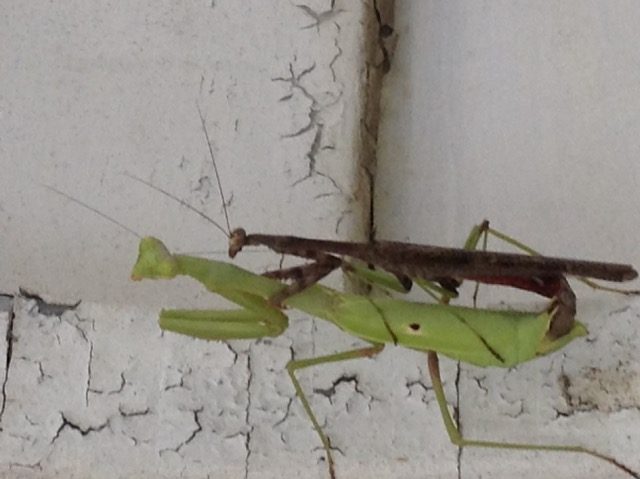Breeding praying mantids is one step further from just keeping praying mantids! It can be really fun and rewarding, but it is also a lot harder than just keeping one or some mantids as pets. For breeding you need one or more female and male pairs that mature at roughly the same time. Then you need to make sure the female does not cannibalize the male before mating takes place. When fertilized eggs are laid in an egg-sack called an ootheca, you need to take care of the eggs to ensure that healthy nymphs hatch.
The difficulty of breeding mantids and raising nymphs strongly varies between species. Some species are relatively easy to breed, while others can only be bred by very experienced mantis keepers. In the species section you can read about the difficulties of specific praying mantis species.
Getting a male – female pair
To breed praying mantids, you need a male and a female. Stick insect females are able to produce fertilized eggs without ever mating with a male (the are parthenogenic), but almost all praying mantis species need fertilization to develop their eggs. How to see the difference between males and females can be read here.
The male and female should mature at roughly the same time to ensure that both partners are able to mate. An old male is often not capable of properly mating with the female. For most species, getting a pair that is a few weeks different in age will do to ensure adults that can be mated, but for other species this does not hold. Some species, for example Hymenopus coronatus, have a big developmental difference between males and females. Males en females from the same egg case will mature at different times, sometimes months apart. The male will already die of old age before the female is mature.

How to put the couple together
For most species, you can follow the following ‘recipe’ to ensure mating between a pair of cannibalistic praying mantids.
- The male and the female should be at least 2 weeks mature
- Both partners but especially the female should be very well fed
- Place both partners in a very large enclosure, the largest you can find.
- Make sure the female is not facing the male but the male is seeing her
- Feed the female with a large prey item, like a cricket
- Do not disturb them.
- Watch if the female is not behaving agressively, like turning around, moving towards or striking at the male. Watch if the male is not running or flying away or moving franticly. If one of such things happen, remove the male and try again the next day.
- When the male has mounted the female, it can taking many hours until he starts mating. Just leave them, do not disturb or feed them.
- When the male dismounts from the female, remove him from the enclosure.
For species that are not (very) cannibalistic like Phyllocrania paradoxa, you don’t need to do anything but put the partners in the same enclosure.
There is no way you can tell if the female has been fertilized or not. She will produce ootheca even if she has not mated. When the female processes the spermatophore of the male, you can find a small white spermatophore leaving her body a few hours / day after mating. If you see this, mating was probably succesfull, but even then you cannot be 100% sure.
When a female has mated, she will remain fertilized all of her life! It is wise to have her mate again if she has produced a lot of ootheca (say after 4 or 5 oothecas).

Keeping the male alive
When mating a male and female praying mantis, the male can be cannabalized by the female. This can happen before, during or after mating. This is something you just have to deal with, especially when keeping cannibalistic species, but there are ways to reduce the chance of having your male killed.
- Feed the female REALLY a LOT before introducing the male
- Have the female eat a prey item when the male is introduced
- Put the pair in a big container or even a room of your house, so the male can escape. They usually know the intention of the female.
- Make sure both partners are calm and not stressed by handling
- Introduce the male in the evening instead of morning or daytime
When breeding praying mantids like this, no more than 10% of your males should be killed even with the most cannibalistic species. And even when the male is killed during mating, the female can still become fertilized.
Demonstration video of how to prevent the male being eaten by an agressive female
Taking care of the ootheca and nymphs
How to care for the mantis ootheca / egg sack and the young nymphs that hatch from it, you can check out our page Caring for mantis eggs


